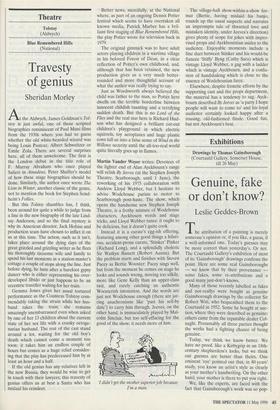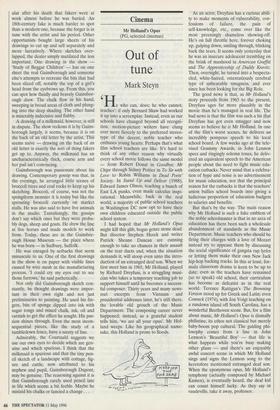Exhibitions
Drawings by Thomas Gainsborough (Courtauld Gallery, Somerset House, till 26 May)
Genuine, fake or don't know?
Leslie Geddes-Brown
The attribution of a painting is merely someone's opinion or, if you like, a guess, if a well-informed one. Today's guesses may be more correct than yesterday's. Or not. The Courtauld Gallery's exhibition of most of its `Gainsborough' drawings confirms the point. Here are some real Gainsboroughs — we know that by their provenance some fakes, some re-attributions and a good many just-don't-knows.
Many of those recently labelled as fakes and not-reallys were bought as genuine Gainsborough drawings by the collector Sir Robert Witt, who bequeathed them to the Courtauld in 1952. Some he bought at auc- tion, where they were described as genuine; others came from the reputable dealer Col- naghi. Presumably all three parties thought the works had a fighting chance of being genuine.
Today, we think we know better. We have no proof, like a Kirbygrip in an 18th- century shepherdess's locks, but we think our guesses are better than theirs. One eminent 'eye' pointed out that, in 40 years' study, you know an artist's style as clearly as your mother's handwriting. On the other hand, your mother is there to put you right. We, like the experts, are faced with the fact that Gainsborough's work was so pop- ular after his death that fakers were at work almost before he was buried. An 18th-century fake is much harder to spot than a modern one, because the forger is in tune with the artist and his period. Other opportunists bought large sheets of his drawings to cut up and sell separately and more lucratively. Where sketches over- lapped, the dealer simply mutilated the less important. One drawing in the show 'Study of Beggar Children' — has on one sheet the real Gainsborough and someone else's attempts to recreate the bits that had been sliced off, notably the top of a girl's head from the eyebrows up. From this, you can spot how fluidly and bravely Gainsbor- ough drew. The chalk flew in his hand, sweeping in broad areas of cloth and plung- ing into the deep shading. The other hand is miserably indecisive and flabby.
A drawing of a milkmaid, however, is still in dispute. The show reckons it is by Gains- borough largely, it seems, because it is on the back of an old letter by the artist. This seems naive — drawing on the back of an old letter is exactly the sort of thing fakers get up to. Anyway, the milkmaid has an uncharacteristically thick, coarse arm and her pail isn't convincing.
Gainsborough was passionate about his drawing. Contemporary gossip was that, in the evenings, he arranged little scenes of broccoli trees and coal rocks to keep up his sketching. Broccoli, of course, was not the spongiform monster it is today but like the sprouting broccoli currently on market stalls. He was also said to have live animals in the studio. Tantalisingly, the gossips don't say which ones but they were proba- bly dogs, sheep and goats. He drew the line at live horses and made models to work from. Today, these are in the Gainsbor- ough House Museum — the place where he was born — in Sudbury, Suffolk.
He was enraged by setbacks that seem minuscule to us. One of the first drawings in the show is on paper with visible lines caused by wire mesh in the manufacturing process. 'I could cry my eyes out to see those furrows,' he said pathetically.
Not only did Gainsborough sketch con- stantly, he thought drawings were impor- tant in their own right and not just preliminaries to painting. He used his fin- gers, bits of sponge dipped into ink with sugar tongs and mixed chalk, ink, oil and varnish to get the effect he sought. His pas- sion shines through. Even the most incon- sequential pieces, like the study of a tumbledown fence, have a surety of line.
Admirably, the Courtauld suggests we use our own eyes to decide which are gen- uine and which spurious. I think that the milkmaid is spurious and that the tiny pen- cil sketch of a landscape with cottage, fig- ure and cattle, now attributed to his nephew and pupil, Gainsborough Dupont, may be genuine. The reasoning against it is that Gainsborough rarely used pencil late in life which seems a bit feeble. Maybe he mislaid his chalks or fancied a change .



































































 Previous page
Previous page